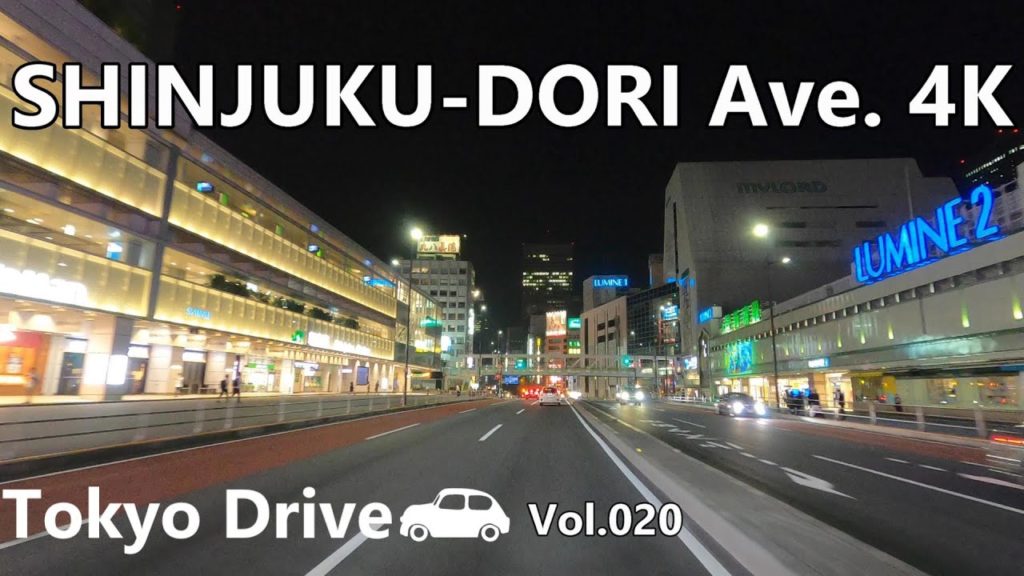[Tokyo Drive] Shinjyuku-Dori Ave. night drive.Tokyo, Japan. Jun.2020.
If you enjoyed the video, please like and subscribe to help the channel grow!
Shinjuku (Japanese: 新宿区, Hepburn: Shinjuku-ku) is a special ward in Tokyo, Japan. It is a major commercial and administrative centre, housing the northern half of the busiest railway station in the world (Shinjuku Station) and the Tokyo Metropolitan Government Building, the administration centre for the government of Tokyo. As of 2015, the ward has an estimated population of 337,556, and a population density of 18,517 people per km². The total area is 18.23 km².Since the end of the Second World War, Shinjuku has been a major secondary center of Tokyo (fukutoshin), rivaling to the original city center in Marunouchi and Ginza. Shinjuku is also commonly used to refer to the entire area surrounding Shinjuku Station. The southern half of this area and of the station in fact belong to Yoyogi and Sendagaya districts of the neighboring Shibuya ward. Shinjuku is surrounded by Chiyoda to the east; Bunkyo and Toshima to the north; Nakano to the west, and Shibuya and Minato to the south. The current city of Shinjuku grew out of several separate towns and villages, which have retained some distinctions despite growing together as part of the Tokyo metropolis. East Shinjuku (or administratively called Shinjuku, Shinjuku-ku): The area east of Shinjuku Station and surrounding Shinjuku-sanchome Station, historically known as Naito-Shinjuku, houses the city hall and the flagship Isetan department store, as well as several smaller areas of interest: Kabukichō: Tokyo’s best-known red-light district, renowned for its variety of bars, restaurants, and sex-related establishments. Golden Gai: An area of tiny shanty-style bars and clubs. Musicians, artists, journalists, actors and directors gather here, and the ramshackle walls of the bars are literally plastered with film posters. Shinjuku Gyo-en: A large park, 58.3 hectares, 3.5 km in circumference, blending Japanese traditional, English Landscape and French Formal style gardens. Shinjuku Ni-chōme: Tokyo’s best-known gay district. Nishi-Shinjuku: The area west of Shinjuku Station, historically known as Yodobashi, is home to Tokyo’s largest concentration of skyscrapers. Several of the tallest buildings in Tokyo are located in this area, including the Tokyo Metropolitan Government Building, KDDI Building and Park Tower. Ochiai: The northwestern corner of Shinjuku, extending to the area around Ochiai-minami-nagasaki Station and the south side of Mejiro Station, is largely residential with a small business district around Nakai Station. Ōkubo: The area surrounding Okubo Station, Shin-Okubo Station and Higashi-Shinjuku Station is best known as Tokyo’s historic ethnic Korean neighborhood after World War Ⅱ. Totsuka: The northern portion of Shinjuku surrounding Takadanobaba Station and Waseda University, today commonly referred to as Nishi-Waseda. The Takadanobaba area is a major residential and nightlife area for students, as well as a commuter hub. Toyama: A largely residential and school area, in the east of Ōkubo and south of Waseda University, extending to the area around Nishi-Waseda Station, Gakushuin Women’s College and Toyama Park. Ushigome: A largely residential area in the eastern portion of the city. Ichigaya: A commercial area in eastern Shinjuku, site of the Ministry of Defense. Kagurazaka: A hill descending to the Iidabashi Station area, once one of Tokyo’s last remaining hanamachi or geisha districts, and currently known for hosting a sizable French community. Yotsuya: An upscale residential and commercial district in the southeast corner of Shinjuku. The Arakichō area is well known for its many small restaurants, bars, and izakaya. “Shinjuku” is often popularly understood to mean the entire area surrounding Shinjuku Station, but the Shinjuku Southern Terrace complex and the areas to the west of the station and south of Kōshū Kaidō are part of the Yoyogi and Sendagaya districts of the special ward of Shibuya. Naturally, most of Shinjuku is occupied by the Yodobashi Plateau, the most elevated portion of which extends through most of the Shinjuku Station area. The Kanda River runs through the Ochiai and Totsuka areas near sea level, but the Toshima Plateau also builds elevation in the northern extremities of Totsuka and Ochiai. The highest point in Shinjuku is Hakone-san in Toyama Park, 44.6 m above sea level.
#tokyodrive#shinjyuku#ドライブ


AloJapan.com